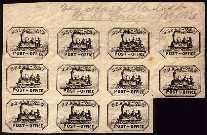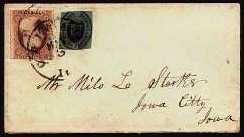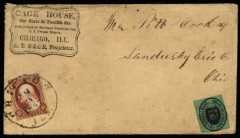
|
<<<< |

|
>>>> |

|

TRAINS ON U. S. STAMPS
and POSTAL STATIONERY
Locals and Expresses
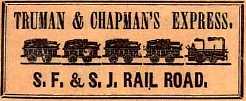
Corner card of Truman and Chapman Express envelope, 1861 |
|
When I first published my pages on Trains on U.S. Stamps, I skipped the
locals and expresses. I owned a few
reproductions of the more common ones - the Broadway, Wyman's, Bronson & Forbes, and Pomeroy - but I had filed them
with my train cinderellas, in keeping with my attitude that they were of no special value or interest philatelically.
The ATA World Railways Philatelic - Digital Download Edition listed none of them at that time, and even its latest
edition, a major revision published in 1999, lists only the Bigelow's, Broadway, and Wyman. So what the heck ARE Locals
and Expresses, and why have they been shunned this way?
Click on any image to see a higher-resolution version.
|
BALDWIN'S RAILROAD POSTAGE
|


BOGUS |
The illustration on the left above is a scan supplied by viewer John Odom (1/3/5),
while that on the right was borrowed (with permission) from the extensive and informative site of
"Zenonas".
Lyons lists two producers of this design, and lists many paper and color combinations, so it must have been printed in large quantities, and distributed widely. The locomotive, like that on the Wyman's stamp, has some characterisitcs of real ones, but also lacks some important ones, such as driver wheels (!), so I doubt the artist had ever seen a real steam locomotive, or had any mechanical knowledge of them.
Note that Lyons describes this as "bogus", meaning either there was no such local post, or there was one, but it issued no such stamp. In this case he is able to attribute the stamps to well-known forgers of the mid-to- late 19th century, which implies they were created with an intent to deceive, rather than to entertain. The AskPhil Glossary (No longer available) describes Baldwin's as a "bogus Canadian local post," and I found references to other sources that describe it the same way, but I wonder how a non-existent entity can be said to have a national origin.
|
Local Posts had a relatively brief life, mostly during the period 1840 to 1860, immediately before and during the early years of the issuance of offical government postage stamps. They grew from the efforts of private individuals and companies to compete with the USPOD in the then rapidly growing business of delivering letter mail. The U.S. Congress soon outlawed competition with the Post Office, and these enterprises died. Expresses were active over a longer period, from 1839 until 1918; indeed, they survive today in the form of enterprises such as UPS and FedEx, though the modern companies no longer create the sort of labels and frankings that interest collectors. One can further separate Expresses into two categories, package expresses and letter expresses (the latter are also known as Independent Mail Companies). The letter expresses were outlawed at the same time as the Local Posts, but the package expresses continued to thrive into the 20th century, since until 1912 the USPS would not carry single items weighing more than four pounds. During the period when they thrived, hundreds of Local and Express companies produced stamps and
handstamps that provide a rich collecting field today. (Click on any image to see a higher-resolution version.) |
BIGELOW'S EXPRESS
|
|||

Bigelow's Boston 1848 |
|
|
Illustrated in Scott, but not numbered or valued: "Authorities consider items of this design to be express company labels rather than stamps." |
|
I could find only one auction image of this item, in Siegel's Hall sale, the cover shown above, though it was one of two in the same lot. Based on that sale, the average value per cover is about $300. The image is detailed enough that identification of the train should be possible, but the best I can say is that it resembles the "Experiment".
|
(Click on any image to see a higher-resolution version.) |
|
Until recently, the absence of a reliable, comprehensive reference
book of Locals and
Independent Mails to aid collectors in sorting out the good from the
bad has discouraged
most from pursuing this area of the hobby. The only book of any
significant scope and
accuracy was Donald Scott Patton's The Private Local Posts of the
United States,
published in 1967. It is still a valuable source of information, but
he completed just
one of the three volumes he had planned, covering only New York State,
and covered
fantasies only sketchily. Fortunately, the recent publications of
Larry Lyons'
monumental 3-volume Identifier for Carriers, Locals, Fakes,
Forgeries and Bogus Posts
of the United States has finally ended the doubt and confusion of
collecting Locals,
by providing a comprehensive, exhaustive reference tool to enable
collectors to know what
is good and what is not. He has covered not only the real posts,
their valid issues and
their forgeries, but also all the fantasies, so one should be able to
identify anything
one encounters. If you are interested in this field, I urge you to
buy a set of the
books, and study them carefully. They may still be available from its
author, or else try one
of the dealers in philatelic
literature.
(Click on any image to see a higher-resolution version.) |
BROADWAY POST OFFICE
|

Lyons
BOGUS |
The illustration above - from Lyons, Volume 1 - is the only one I have been able to find of this item, but considering the number of different varieties he cites, it must be fairly common. The train does not quite match any I could find, but looks reasonably authentic, and most like two UK trains of the period the Bury and Firefly, but not exactly either.
|
It was at the urging of several fellow train-stamp collectors that I
decided finally to
add the Locals, etc. to these pages. I expected the research would be
a quick, simple
task, and would reveal perhaps one or two items more than the five I
already knew. It
has taken me over a week, and I was pleasantly surprised to find a
total of nineteen
items I deemed worthy of inclusion - I expect a few more will turn up.
Some readers may
disagree with my choices, but I decided to include every item I could
find, including
labels, handstamps and all other markings: if it depicts a locomotive
or train car and
was supposedly issued by a local, carrier, or express, I show it. And
I have included
fantasies/bogus items, as Lyons does in his books, so that anyone
consulting these pages
to identify what purports to be a local or express item will be able
to find it.
(Click on any image to see a higher-resolution version.) |
BRONSON & FORBES
|
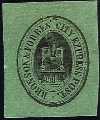
Bronson & Forbes Chicago 1856
Scott 27L1 |

Bronson & Forbes Chicago 1856
Scott 27L2 |
Bronson & Forbes is another widely forged local, and authentic copies are quite scarce, as indicated by the Scott values shown. The only "multiple" I could find was the reconstructed pair shown above, from Siegel sale 825. The copy of the black on lilac paper version shown above is the only authentic one known. The auction writeup for its most recent outing is instructive:
W. H. Bronson and G. F. Forbes operated their local post in Chicago from mid-1856 through early 1857, based on the most reliable evidence. A March 1855 cover is recorded, but its early date and the absence of dated examples from the following fourteen months make it doubtful that the stamp originated or that the date was reported accurately. The post probably closed in 1857. The Chicago city directories support this date span.
Fewer than a dozen Bronson & Forbes covers are known, and all but two have uncancelled stamps. A large circular datestamp is known in black, but there is no other example of a red handstamp used by this post. The stamp on this piece has all of the characteristics of the Black on Green issue, and we have complete confidence in the genuineness of this Black on Lilac stamp. However, we are of the opinion that the red handstamp is faked. The stamp was probably used on this piece and left uncancelled, as usual for this post. Offered as a genuine stamp but "as is" with respect to the cancel.
The estimated value of this item was $4,000-5,000 (Siegel auction 830, Nov 13-14, 2000), which seems cheap for the only known example. It sold for $3,250 + 10%. It strikes me as tragic that someone was both so greedy and so foolish as to tamper with an item that was already unique, and thereby REDUCE its value!
The two covers above, both in the same recent auction, illustrate an interesting factor of the philatelic marketplace, though one could debate which one. It may be the value of featuring an auction item with its own page, a detailed analysis, and a high estimate; it may be the effect of competition among determined bidders; or it may be the real value of rarity. The one on left - with a full page of its own in the catalog and a three paragraph writeup - sold for $9,000 + 10%" against an estimate of $4,000-5,000, while the one on the right - sharing a page with two similar covers and granted only one short parahraph of text - sold for $800 + 10%" against an estimate of $1,000- 1,500. The key difference between the two covers is that on the cover on the left, the local is tied by the postmark. The cover on the right actually has a better copy of the local, but not tied. The cover on the left is the ONLY cover with a Bronson & Forbes stamp tied. Note that it sold for almost three times as much as the unique copy of the lilac paper variety.
The head-on view of the locomotive on this stamp may make it impossible to identify the train, presuming it was based on a real one, but is obviously a more contemporary design, with cow-catcher, flared smokestack, and enclosed engineer's cabin.
|
Click on any image to see a higher-resolution version. |
US TRAINS
|
Please note that ALL of the stamps illustrated on this page are considered to be genuine,i.e., not counterfeits, though some, as I have indicated, are fantasies or bogus issues, i.e., there was no such local or express. I do not wish to attempt to duplicate Larry Lyons' efforts here by showing fakes and explaining how to identify the real thing, so I have used scans from auction catalogs where I could find them, and copied the Lyons illustration only where his was the only one available to me. If you think I am wrong, and something I show is a reproduction or forgery, please email the webmaster at posterstampcc@gmail.comIf you have a better scan to share with the world, I would welcome that too.
REFERENCES
Identifier for Carriers, Locals, Fakes, Forgeries and Bogus
Posts of the United
States, Larry Lyons; published by the author, 1998
The subtitle of this book is "A Study of the Identification of the
Local Stamp Adhesive
from the Forgeries and Bogus Posts". It is NOT a history, catalog, or
pricing guide, and
while I would love to see it expanded in those as well as other
directions, I am very
pleased with it just as it is. Use it to determine whether the stamp
you have is an
authentic local post adhesive or some sort of fake, forgery or fantasy.
Catalog of Private Express Labels and Stamps, Bruce Mosher; published by the author, 2002,
REVISED EDITION 2018.
A magnificent book listing and illustrating
over 2000 labels issued by private express companies in the US and Canada.
The Private Local Posts of The United States, Volume 1,
Patton, Donald
Scott; pub. Robson Lowe, London, 1967
This is still a very useful tool in studying the area, as it includes
extensive text
discussions of the posts themselves, plus reproductions of some of
their cancellations,
which are of great value and interest to postal historians.
Scott 1997 Specialized Catalog of U.S. Stamps
I used this for the prices and some of the dates I quote above.
The David Golden Collection of United States Carriers and
Locals
pub. Siegel Auction Galleries, 1999
This was the auction catalog for Siegel's sale 817, November 15-17,
1999, and in keeping
with their recent efforts to create a serious reference resource for
collectors, in both
their catalogs and their web
site, it contains not only high-quality phoitographs of most of
the lots, but also
scholarly writeups about both the local posts themselves and the
stamps and covers.
The Hall Collection of United States Carriers, Locals, and
Western Expresses
pub. Siegel Auction Galleries, 2000
This was the auction catalog for Siegel's sale 830, November 13-14,
2000, and is another
essential reference work for the serious student, with superb
photographs and writeups.
Below are some of the sites I link to above - the ones I think are worth visiting and browsing through.
Colorado & Southern Rolling-
stock
This website is dedicated to the narrow gauge rolling-stock that the Colorado & Southern Railroad ?inherited? from four
of its numerous predecessor railroads (and such others as just might accidentally creep in)
I have reproduced all the labels that have a train image on them
HERE.
SAMPLE PAGES HERE
ORDERING INFORMATION HERE
It is still deficient in its coverage of Locals and Expresses,
treating the latter
especially poorly.
LINKS
All text Copyright © 2000, William M. Senkus
Send feedback to the webmaster: CLICK HERE
Revised -- 07/29/2018





